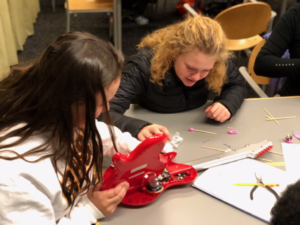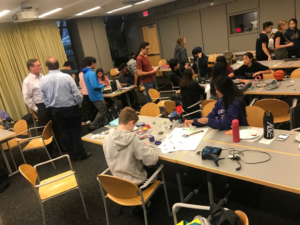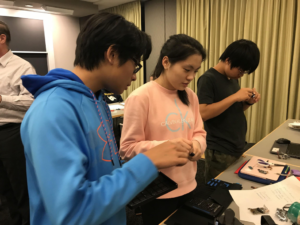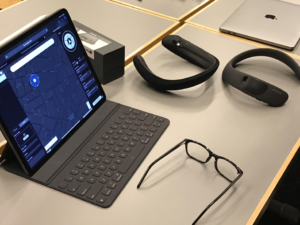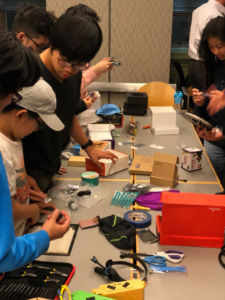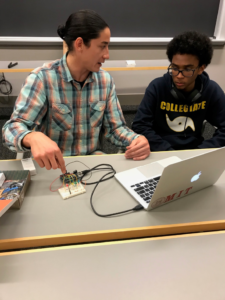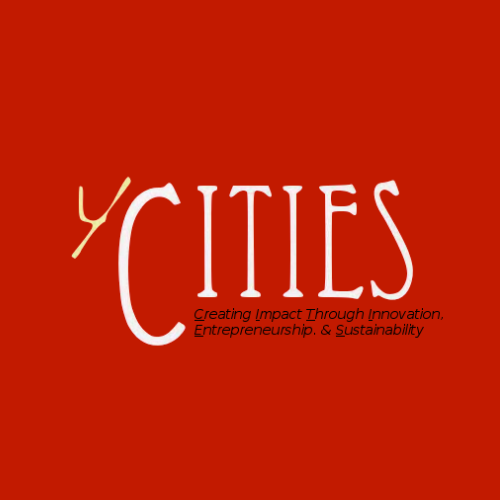At the end of last week’s blog I mentioned a conversation we had as a class about playing basketball with a visual impairment. This discussion came up again in Class Four, and Vicky Wu Davis, Sanibel’s mother, went into more detail on the conversation in the latest blog post. I’d like to use this example again to illustrate some of the main points of this week’s class.
As a class we discussed potential problem areas and entered a high level discussion about ways that technology could solve particular problems that a blind individual might encounter. One student, Vicky’s eleven year old son, brought up a great point that implementing this technology in a basketball game could lead to unfairness on the court or even cheating, giving a player with a visual impairment an upper hand over other players. For example, if a player has technology that can provide spatial awareness and real time location of other players through the use of “audible footprints,” does that give them an upper hand over other players despite the existing visual impairment that technology seeks to overcome? It was a really great question, reminding us that technological innovation doesn’t exist in a bubble, and that when a technology is developed to solve one problem, its implementation in the real world can potentially open up a slew of other advantages/disadvantages that compound the existing context. It can be a difficult thing to predict, but understanding what secondary issues might emerge from solving the identified problem is an extremely important consideration.
But thankfully there is a way to prevent and consider these concerns about cheating! And that’s to prototype and test your ideas! Even in large scale companies like Bose and Boston Children’s Hospital, it would never be feasible to create an entirely new product, do all the technical engineering, and put it out on the market, and that’s what Class Four’s co-instructors Scott Stephens and Brendan Kohler came to discuss. Both of them come from a technical background, and I think it’s important for students to hear this sort of advice from people with considerable technical experience in their respective industries. As engineers it’s of course extremely important to develop technical skills, but in popular media we seldom see all of the behind the scenes analysis and testing that goes into deciding whether a technical innovation should be made in the first place. (Seriously, there is no way that Tony Stark made his perfectly capable Iron Man suit in a few days on his first try!)
Getting back to our magic basketball audible footprints, as Scott and Brendan echoed in their lecture, we probably aren’t going to build the whole infrastructure for our basketball device from scratch. Given that we’re working with Bose Frames, let’s just assume for now that this basketball device is some sort of glasses. Am I going to make a whole new pair of audio glasses for this? No! Bose already proved that it can be done, so I don’t need to reprove the same hypothesis that Bose proved for me. But maybe I have questions about how glasses would work when I’m playing basketball. They might fall off, get crushed, or be loose on my face, so I probably have to design a way for these to fit well on the user’s head and still deliver audio in the right way. In this case, I would likely create what’s known as a looks like prototype. I don’t need to test the core technology (yet), so instead I’m going to create a simple prototype that tests the form factor of the glasses and test them with the user.
By the way, who is my user? As a refresher, the students are working with Sanibel, a four year old girl with a number of vision related problems who’s just getting into sports as both a spectator and a player. Sanibel is four, so she likely isn’t going to be playing professional basketball quite yet. In Class Three we started to lose sight of our user just a little, and it’s important to remember that at this point in Sanibel’s life that the class is designing for, she doesn’t have professional teammates and opponents that would be impacted by her use of a new audio device, but she does have brothers, friends, her mom, and her dad who might want to find ways for Sanibel to get better at basketball so that she is prepared to overcome the challenges of playing on a team later on in life. For early prototyping, the context in which the technology is to be used is extremely important, and needs to be understood before diving into technical solutions. Otherwise we end up creating a solution for the NBA that has no use for a four year old. Consider this a technical foul on our end. (Ha, see what I did there? I’ll see myself out now…)
Anyway, now with a better understanding of the user and some ideas for the looks-like prototype of these glasses, the next thing I have questions about is how the audio technology for the “audible footprints” will work. I could go spend three years holed-up creating a machine learning technology that identifies players on the court and reads their location back to the player in real time, but that doesn’t sound like a great use of my time. What if I’m wrong or nobody wants it? To discourage this sort of early prototyping, Emma Boyd, a previous L3 Innovation Challenge winner, discussed her work on the Virtual Foot, a shoe insole that connects to a gamified experience for kids with running and jumping actions to encourage healthy behavior. Instead of developing a complex shoe insole with all of the necessary technology for bluetooth, game inputs, and other sensors, Emma first wanted to test that the idea was valid. She met with a group of 5th graders, her target demographic, and had them play Temple Run (the mobile endless runner game). Instead of actually playing, she had the kids run and jump while she hid behind a projector screen, swiping on an iPad to mimic the inputs of actual running and jumping that she imagined her working Virtual Foot device would be able to test on her own. By doing this she gained valuable feedback about whether the kids enjoyed the experience and how easy it would be to run and play the game simultaneously. This strategy, known as Wizard of Oz prototyping, allows us as designers and entrepreneurs to play pretend with certain elements of our solution, a method famously employed by Zappos when they bought shoes and shipped them to customers themselves before the idea of buying shoes on the internet had ever been done. Similarly, if I were working on the basketball glasses with Sanibel, my first test of the audible footprints, wouldn’t be to design an AI platform, but rather to shout out from the sidelines where her brothers and friends are relative to her, the ball, and the net, and to use that experience as a way to narrow down what kind of spatial information is most important for Sanibel, how she responds to it, and what the device should say. She might prefer I just keep quiet in the first place!
Once the general idea of the talking basketball glasses has been clarified by my early stage prototyping, then I might feel more comfortable creating a works like prototype, finding ways to develop low fidelity versions of the technology necessary to support what I’ve learned about how Sanibel responds to audible footnotes and how she likes the fit of the sport glasses from my looks like prototype. I go into further detail on this concept in my previous blog about the next steps to prototype for Mary Mcmahon’s Ahead of the Curve venture.
After Scott and Brendan’s lecture, the students broke into their assigned teams and brainstormed a number of ideas around a particular scenario in Sanibels’ daily life that they saw as a problem and wanted to improve. The exercise was fast and nobody had all the details figured out. As a class, we reviewed their ideas and discussed what was good about the idea and what would potentially be tricky about the idea. Some of these ideas included a shoe with sensors to give feedback if Sanibel is about to hit something, a headband with audio technology to provide details when watching a sports game, and glasses that literally adjust the position of Sanibel’s eye in the manner she does on her own right now. The ideas were all bold and addressing key problems the students identified from their time with Sanibel. After sharing, we split off into one of the best parts of the course, the deconstruction party, where the students played with pieces of tech and took them apart to start making their own early stage prototypes, in addition to learning more about Bose AR and Arduino. It’s better if you just take a look at the photos below. I’m excited to dig into some of the teams actual ideas following next week’s class, when they’ll have had a chance to share their prototypes with Sanibel and get her feedback. We’ll be helping as mentors along the way to make sure they are asking the right questions and designing the right tests to get valuable feedback from her, so stay tuned!
